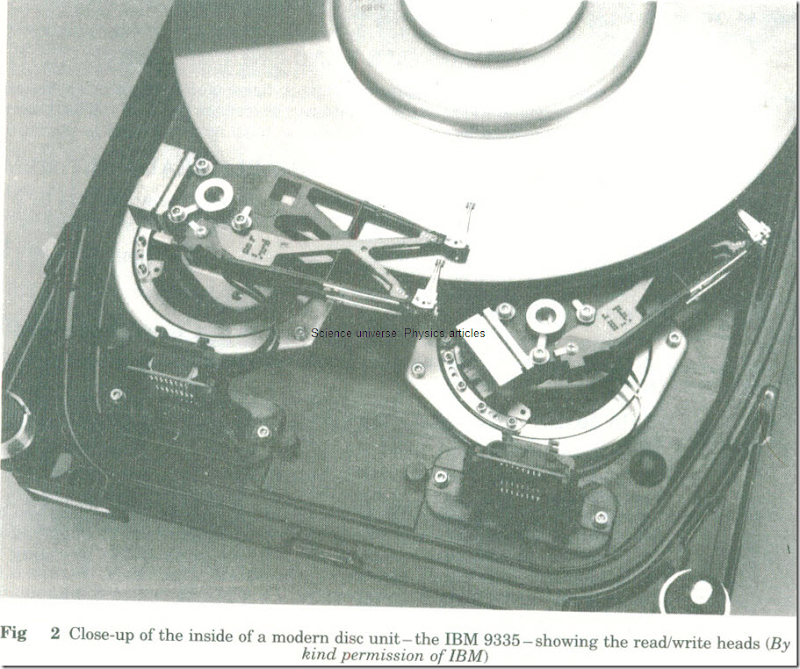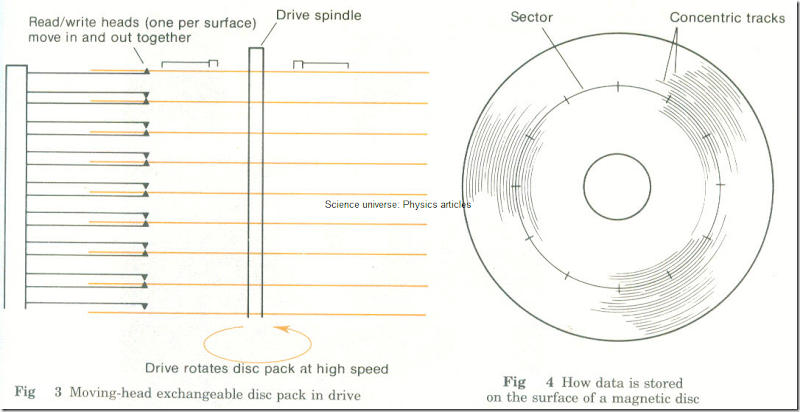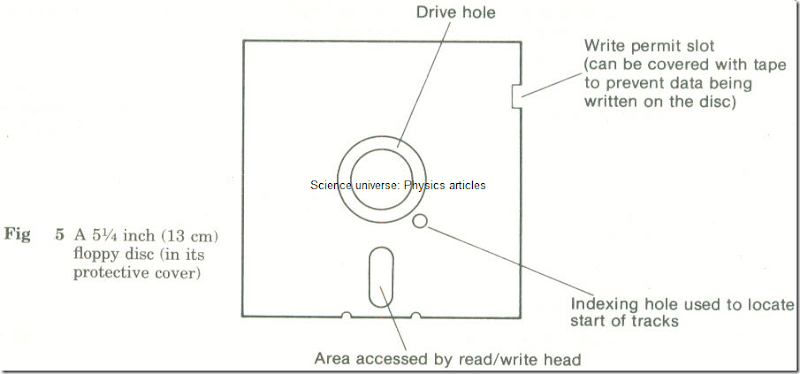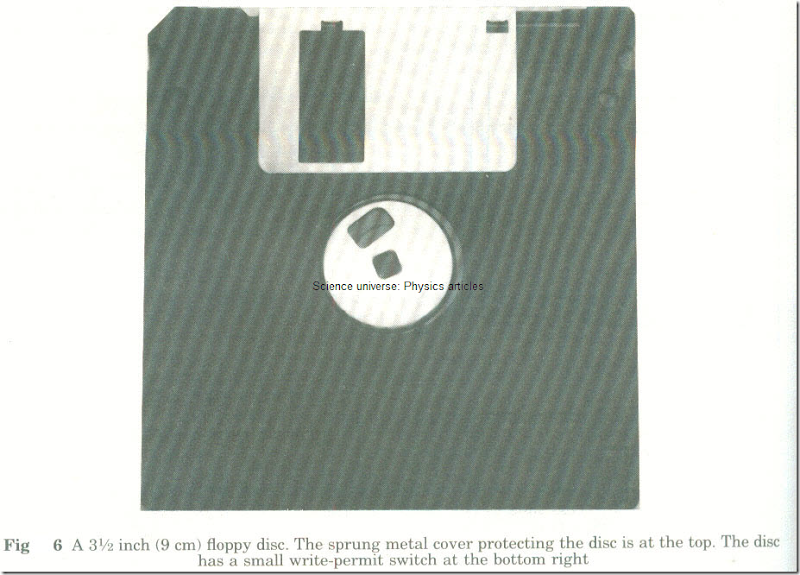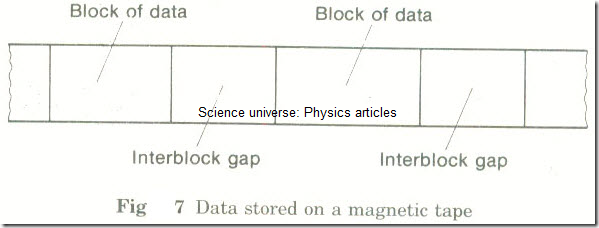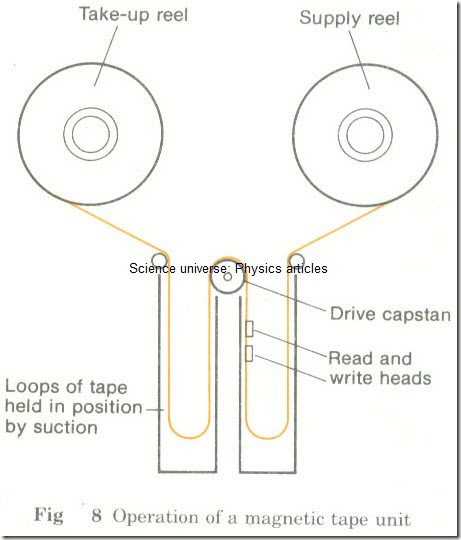Backing Stores
Backing stores are either serial access or direct access.
Direct access store is backing store for which any data item can be accessed without reading any other data first.
Magnetic discs are the most common type of direct access store.
Serial access store is backing store for which all data between the present read/write position and the required one has to be passed over before the data can be accessed.
Magnetic tapes are the most common type of serial access store.
DIRECT ACCESS BACKING STORES
The main types are magnetic but optical methods are being used increasingly:
1 Hard discs accessed by moving heads.
2 Hard discs accessed by fixed heads.
3 Floppy discs.
4 Bubble memory.
5 Optical storage-compact discs.
1 Hard discs with moving heads
These are the discs commonly used for on-line backing storage on large computers. They are almost always interchangeable and often in a pack. One important exception to this is the small type of hard disc used in microcomputers. These are fixed and are sealed to prevent contamination by dust and moisture.
Exchangeable means the disc (or pack) is not permanently fixed in the drive but can be taken out and replaced by another one.
A disc pack is a set of discs held parallel to one another by a spindle. When in use the discs rotate together. The read/write heads pass between the discs very close to the surface.
Fig 2 Close-up of the inside of a modern disc unit c the IBM 9335-showing the read/write heads (By kind permission of IBM)
There is one head per surface and the heads cannot move independently of one another, but move together like a comb (Fig 3). Usually all the surfaces are coated with magnetic material and used for storage except the outer ones. Thus on a pack of six discs ten surfaces would be used.
Each surface holds data in a set of concentric tracks, and each track is divided into sectors (Fig 4).
For a disc pack, a group of tracks vertically above one another is called a cylinder. Since the heads move together, data is written to or read from all the tracks in one cylinder before moving to the next cylinder.
Drive rotates disc pack at high speed Fig Moving-head exchangeable disc pack in drive Fig How data is stored on the surface of a magnetic disc
The access time for moving head discs is given by:
Access time = Seek time + Rotational delay + Transfer time
Uses
1 General storage of users’ files.
2 Storage of frequently used programs.
3 Storage of programs and data which are queueing to be dealt with by the computer.
4 Storage of data waiting to be printed.
2
Hard discs with fixed heads
These are very similar to moving-head discs except that there is a read/write head for every track of every surface.
Characteristics of fixed-head discs
1 The disc packs are usually not exchangeable, often the drive unit is a closed box and the discs are not visible.
2 The heads do not move. There is no seek time so:
Access time = rotational delay + Transfer time
Thus access is faster than for moving-head discs.
3 They are relatively expensive.
3 Floppy discs
Fig 5 A 51/4 inch (13 cm) floppy disc (in its protective cover)
Fig.6 A 3 1/2 inch (9 cm) floppy disc. The sprung metal cover protecting the disc is at the top. The disc has a small write-permit switch at the bottom right
A floppy disc is a single flexible disc held in a protective jacket. Diameters vary but 8 inches (20 cm), 5 1/4 inches (13 cm) and 3 1/2 inches (9 cm) are common. The larger floppy discs have to. be kept carefully in a small wallet. This is because part of the magnetized surface is exposed to allow contact with the read/write heads (Fig. 5). The smaller discs are protected by a sprung metal cover (Fig. 6).
Usually both sides of the disc are coated with magnetic material, although sometimes only one side is used. There is only one read/write head for each surface used. The discs are exchangeable. Data is stored on them in much the same way as on the larger hard discs.
Uses
1 Floppy discs were originally developed as a replacement for cards as a data preparation medium. In this role they are highly successful .
2 They are also widely used now as backing stores for microcomputers and word processors.
4 Bubble memory
A film of magnetizable material has metal circuit patterns deposited on top of it. The bubbles
consist of small areas of the material, magnetized in one of two directions to represent 1 or 0. Although the material itself does not move a bubble can effectively be ‘moved’ by inducing the same magnetic field in another area nearby using electric currents. The bubbles can thus be moved to a point where they can be read or written, without any mechanical movement. Bubble store is not volatile and so can be used as backing store.
5 Optical storage-compact discs
New methods are being introduced for storing data. These include compact audio discs for storing music and video discs for storing pictures and films. The discs have a highly polished surface with data stored as small pits in the surface. The equipment to read them uses a laser.
The data on the discs is digital, not analogue as on conventional records and tapes. For this reason these media can be used for storing computer data.
One problem is that the system is read only at the moment. Data can be read from the discs but not written on to them. However, a system has been produced called the CD ROM, which can store 550 megabytes.
SERIAL ACCESS BACKING STORES
1 Standard magnetic tape
Standard computer tape is in reels half an inch (1 1/4 cm) wide and 2400 feet (730 metres) long.
Increasingly tape is being used in the form of a cartridge. This is better protected from dirt and easier to use, but usually contains less tape. Cartridges are now available which are smaller than reel-to-reel tapes but store more data.
Even smaller cartridges are used in tape streamers. A tape streamer is a unit used to store the contents of discs as a ‘back-up’ -so that the data can be retrieved if there is a disc failure.
On magnetic tapes data is usually held on seven or nine parallel tracks along the tape, one frame across the tape representing one character .
Data is stored on the tape in blocks (Fig 7). A block is the amount of data that can be transferred as a unit between the CPU and a backing store.
Fig 7 Data stored on a magnetic tape
Reel-to-reel tape units usually have loops of tape held by a vacuum to stop the tape breaking as the unit starts and stops (Fig 8). It is still necessary to have quite large lengths of blank tape in between the blocks to allow for acceleration and deceleration. These lengths are called interblock gaps.
Fig 8 Operation of a magnetic tape unit
Worked question
A computer file is stored on magnetic tape which has blocks of 512 characters each. The file consists of 1000 records of 25 characters each. A block cannot store parts of records-that is if there is not enough room in a block for the whole of a particular record it must go in the next block. How many blocks are needed to store the file?
512/25 is equal to 20.48
So 1 block can hold 20 records
Number of blocks needed = 1000/20
=50
2 Tape cassettes
Standard tape cassettes are used as low-cost backing store for microcomputers.
Data is usually stored on a single track. Two different frequencies of sound are used to represent 0 or 1, the bits of each character of data following one another along the tape . Transfer is very slow in comparison with other media- typically 30 to 120 characters per second (300 to 1200 baud).

